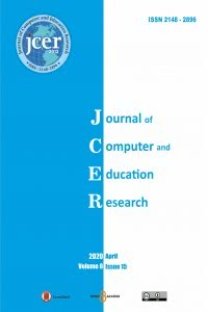STUDENT TEACHING ENHANCEMENT PROGRAM (STEP) AND PRESERVICE TEACHERS’ TEACHING EFFICACY IN SCIENCE
Öğrenci Öğretim Geliştirme
___
Bandura, A. (1977). Self-efficacy: Toward a unifying theory of behavioral change. Psychological Review, 84(2) 191-215.Chapman, M., Polly, D., Frazier, W., Hopper, C., & Britt, M. (n.d.). Supporting Elementary Education Yearlong Interns. Unpublished manuscript, UNC Charlotte Scholarship for Teaching and Learning Grants Program.
Cheng, E. C. (2013). Enhancing the Quality of Pre-service Teachers’ Learning in Teaching Practicum. Unpublished manuscript, The Hong Kong Institute of National Library.
Cheng, Y. (2008). Paradigm Shift in Pre-Service Teacher Education: Implications for Innovations and Practice. In C. P. Lim, K. Cock, G. L. & C. Brook (Eds.) Innovative Practices in Pre-Service Teacher Education an Asia-Pacific Perspective (pp. 3-22). Rotterdam: Sensepublishers
Joseph, J. (2010). Does intention matter? Assessing the Science teaching efficacy beliefs of pre-service teachers as compared to the general student population. Electronic Journal of Science Education, 14(1), 2-14.
-
Karimvand, P. (2011). The Nexus between Iranian EFL Teachers’ self-efficacy, teaching experience and gender. English Language Teaching, 4(3), 171-183.
Lopes, A., & Tormenta, R. (2010). Pre-service teacher training, primary teachers’ identities, and school work. Literacy Information and Computer Education Journal (LICEJ), 1(1), 52-58.
MacGregor, D. (2009). Identity formation – Influences that shape beginning teachers’ professional identity – Crossing the border from pre-service to in-service teacher. Paper presented at the annual conference of the Australian Teacher Education Association (ATEA).
Montebon, D. R. (2015), A needs assessment survey on Teacher Readiness of Science Pre-Service Teachers: Towards a Contextualized Student Teaching Enhancement Program (STEP). International Journal of Learning, Teaching and Educational Research, 10(3), 17-26.
Oh, S. (2010). The sources that influence student teachers’ sense of efficacy. Unpublished doctoral dissertation, Iowa State University.
Organizatin for Economic Co-operation and Development (OECD), (2009). Creating Effective Teaching and Learning Environments: First Results from TALIS. Retrieved May 24, 2015 from http://www.oecd.org/berlin/43541702.pdf
Pendergast, D., Garvis, S., & Keogh, J. (2011). Preservice student teacher self-efficacy beliefs: An insight into the making of teachers. Australian Journal of Teacher Education, 36(12), 45-57.
Tschannen-Moran, M., & Hoy, A. (2001). Teacher efficacy: Capturing and elusive construct. Teaching and Teacher Education, 17, 783-805.
Watson, G. (2006). Technology Professional Development: Long-Term Effects on Teacher Self-Efficacy. Jl. of Technology and Teacher Education, 14(1), 151-165.
Yılmaz, H. & Çavaş, P. (2008). The effect of the teaching practice on pre-service elementary teachers’ science teaching efficacy and classroom management beliefs. Eurasia Journal of Mathematics, Science & Technology Education, 4(1), 45-54.
- Yayın Aralığı: 2
- Başlangıç: 2013
- Yayıncı: Tamer KUTLUCA
WEB TABANLI ÖĞRENME ORTAMINDA VERİ MADENCİLİĞİNE DAYALI ÖĞRENCİ DEĞERLENDİRMESİ
PRESERVICE SCIENCE TEACHERS’ VIEWS ON THE TRAINEESHIP APPLICATIONS
Cemal AKÜZÜM, Murat Berat UÇAR, Fatma Melike HIDIROĞLU
STUDENT TEACHING ENHANCEMENT PROGRAM (STEP) AND PRESERVICE TEACHERS’ TEACHING EFFICACY IN SCIENCE
EXAMINING SECONDARY SCHOOL STUDENTS’ ATTITUDES TOWARDS VISUAL ARTS COURSE
Günay PALİÇ ŞADOĞLU, Ali Rıza AKDENİZ
8.SINIF ÖĞRENCİLERİNİN EPİSTEMOLOJİK İNANÇLARI İLE PISA BAŞARILARI VE FEN VE TEKNOLOJİ OKURYAZARLIĞI
